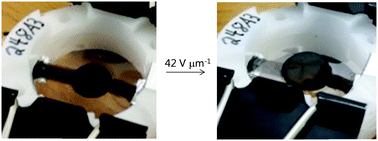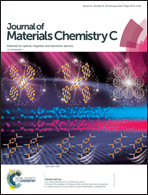Dielectric elastomer actuators with increased dielectric permittivity and low leakage current capable of suppressing electromechanical instability†
Abstract
Dielectric elastomers with increased dielectric permittivity (ε′), excellent insulating and mechanical properties have a broad application potential ranging from flexible electronics to dielectric elastomer transducers. Until now, several reports exist on elastomers with increased permittivity, but unfortunately in most cases this increase in permittivity is associated with an increase in conductivity, which detrimentally affects the insulating properties, such as the leakage current and dielectric breakdown. Here, novel polysiloxane based elastomers were prepared in three steps starting from a silanol end-terminated poly(methylvinyl)siloxane, whose vinyl groups were reacted with alkyl thiols via a thiol–ene reaction. The resulting polymers were cross-linked using condensation reactions and the dielectric, mechanical and electromechanical properties were evaluated. Eventually, an optimized material with a relative permittivity of ε′ = 5.4, a conductivity of 4 × 10−11 S cm−1, a storage modulus of 300 kPa, and a mechanical loss factor below 0.05 was achieved. Actuators constructed from this optimized material showed no electromechanical instability in the absence of prestrain. An area actuation strain of about 200% at an electric field of 53 V μm−1 was achieved. This excellent electromechanical behavior can be rationalized by the increased permittivity due to the thioether side chain and its favorable strain-stiffening effect on the material when crosslinked with polar alkoxysilanes. The actuators gave a stable lateral actuation strain of 10% for more than 50 000 cycles when subjected to an electric field of 27 V μm−1 at a modulation frequency of 8 Hz. Due to the combined properties of this material such as a low leakage current density of 0.5 μA cm−2 at 27 V μm−1, an attractively low glass transition temperature, a very fast electromechanical response and an increased permittivity, the dielectric elastomers developed in this work may be considered as a future replacement for polydimethylsiloxane elastomers in dielectric elastomer transducers.



 Please wait while we load your content...
Please wait while we load your content...